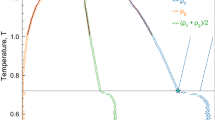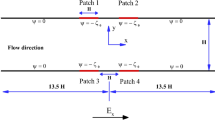Abstract
Phase separation in liquid mixtures is mainly controlled by temperature and pressure, but can also be influenced by gravitational, magnetic or electric fields. However, the weak coupling between such fields and concentration fluctuations limits this effect to extreme conditions1,2,3. For example, mixing induced by uniform electric fields is detectable only at temperatures that are within a few hundredths of degree or less of the phase transition temperature of the system being studied4,5,6,7. Here we predict and demonstrate that electric fields can control the phase separation behaviour of mixtures of simple liquids under more practical conditions, provided that the fields are non-uniform. By applying a voltage of 100 V across unevenly spaced electrodes about 50 µm apart, we can reversibly induce the demixing of paraffin and silicone oil at 1 K above the phase transition temperature of the mixture; when the field gradients are turned off, the mixture becomes homogeneous again. This direct control over phase separation behaviour depends on field intensity, with the electrode geometry determining the length-scale of the effect. We expect that this phenomenon will find a number of nanotechnological applications, particularly as it benefits from field gradients near small conducting objects.
This is a preview of subscription content, access via your institution
Access options
Subscribe to this journal
Receive 51 print issues and online access
$199.00 per year
only $3.90 per issue
Buy this article
- Purchase on Springer Link
- Instant access to full article PDF
Prices may be subject to local taxes which are calculated during checkout




Similar content being viewed by others
References
Landau, L. D. & Lifshitz, E. M. Elektrodinamika Sploshnykh Sred Ch. II, Sect. 18, problem 1 (Nauka, Moscow, 1957)
Greer, S. C., Block, T. E. & Knobler, C. M. Concentration gradients in nitroethane + 3-methylpentane near the liquid-liquid critical solution point. Phys. Rev. Lett. 34, 250–253 (1975)
Moldover, M. R., Sengers, J. V., Gammon, R. V. & Hocken, R. J. Gravity effects in fluids near gas-liquid critical point. Rev. Mod. Phys. 51, 79–99 (1979)
Debye, P. & Kleboth, K. Electrical field effect on the critical opalescence. J. Chem. Phys. 42, 3155–3162 (1965)
Early, M. D. Dielectric constant measurements near the critical point of cyclohexane-aniline. J. Chem. Phys. 96, 641–647 (1992)
Wirtz, D. & Fuller, G. G. Phase transitions induced by electric fields in near-critical polymer solutions. Phys. Rev. Lett. 71, 2236–2239 (1993)
Orzechowski, K. Electric field effect on the upper critical solution temperature. Chem. Phys. 240, 275–281 (1999)
Rowlinson, J. S. & Swinton, F. S. Liquids and Liquid Mixtures (Butterworths, London, 1982)
Sengers, J. V., Bedeaux, D., Mazur, P. & Greer, S. C. Behavior of the dielectric constant of fluids near a critical point. Physica. A 104, 573–594 (1980)
Amundson, K., Helfand, E., Quan, X. N., Hudson, S. D. & Smith, S. D. Alignment of lamellar block-copolymer microstructure in an electric-field. 2. Mechanisms of alignment. Macromolecules 27, 6559–6570 (1994)
Onuki, A. Electric-field effects in fluids near the critical point. Europhys. Lett. 29, 611–616 (1995)
Pohl, H. A. Dielectrophoresis (Cambridge Univ. Press, Cambridge, UK, 1978)
Christen, T. Homogenization of nonuniform electric fields in mixtures of liquid dielectrics. Appl. Phys. Lett. 76, 230–232 (2000)
Melcher, J. R. & Taylor, G. I. Electrohydrodynamics—A review of the role of interfacial shear stresses. Annu. Rev. Fluid Mech. 1, 111–146 (1969)
Schäffer, E., Thurn-Albrecht, T., Russell, T. P. & Steiner, U. Electrically induced structure formation and pattern transfer. Nature 403, 874–877 (2000)
Tsori, Y. & Andelman, D. Thin film diblock copolymers in electric field: Transition from perpendicular to parallel lamellae. Macromolecules 35, 5161–5170 (2002)
Berge, B. & Peseux, J. Variable focal lens controlled by an external voltage: An application of electrowetting. Eur. Phys. J. E 3, 159–163 (2000)
Comiskey, B., Albert, J. D., Yoshizawa, H. & Jacobson, J. An electrophoretic ink for all-printed reflective electronic displays. Nature 394, 253–255 (1998)
Pollack, M. G., Fair, R. B. & Shenderov, A. D. Electrowetting-based actuation of liquid droplets for microfluidic applications. Appl. Phys. Lett. 77, 1725–1726 (2000)
Lifshitz, E. M. & Landau, L. D. Statistical Physics 2nd edn (Butterworth-Heinemann, New York, 1980)
Khusid, B. & Acrivos, A. Effects of interparticle electric interactions on dielectrophoresis in colloidal suspensions. Phys. Rev. E 54, 5428–5435 (1996)
Kumar, A., Qiu, Z., Acrivos, A., Khusid, B. & Jacqmin, D. Combined negative dielectrophoresis and phase separation in nondilute suspensions subject to a high-gradient ac electric field. Phys. Rev. E 69, 021402 (2004)
Rosensweig, R. E. Ferrohydrodynamics (Dover, New York, 1998)
Korda, P. T., Taylor, M. B. & Grier, D. G. Kinetically locked-in colloidal transport in an array of optical tweezers. Phys. Rev. Lett. 89, 128301 (2002)
Grier, D. G. A revolution in optical manipulation. Nature 424, 810–816 (2003)
De Gennes, P. G. Scaling Concepts in Polymer Physics (Cornell Univ. Press, Ithaca, New York, 1979)
Acknowledgements
We thank D. Andelman and P. G. de Gennes for discussions and suggestions, and R. Bonnecaze and A.-V. Ruzette for comments on the manuscript. We gratefully acknowledge support from ATOFINA.
Author information
Authors and Affiliations
Corresponding author
Ethics declarations
Competing interests
The authors declare that they have no competing financial interests.
Supplementary information
Supplementary Animation 1
Temperature induced phase separation: The Paraffin-silicone oil mixture (42.7% w/w of squalane in polymethylphenylsiloxane) is cooled down (-0.1°C/mn) from above to below the phase separation temperature Tt= 80.4°C. No voltage is applied, droplets appear throughout the sample. (AVI 3294 kb)
Supplementary Animation 2
Electric field gradient induced phase separation: Same sample at T=Tt + 0.1 °C (homogeneous state). A voltage (500 V a.c.) is applied across ITO transparent electrodes separated by a 50µm gap. A silicone rich channel appears along the electrode edges. (AVI 1032 kb)
Rights and permissions
About this article
Cite this article
Tsori, Y., Tournilhac, F. & Leibler, L. Demixing in simple fluids induced by electric field gradients. Nature 430, 544–547 (2004). https://doi.org/10.1038/nature02758
Received:
Accepted:
Issue Date:
DOI: https://doi.org/10.1038/nature02758
This article is cited by
-
Phase Separation of Polymer Blends Induced by an External Static Electric Field
Chinese Journal of Polymer Science (2023)
Comments
By submitting a comment you agree to abide by our Terms and Community Guidelines. If you find something abusive or that does not comply with our terms or guidelines please flag it as inappropriate.



